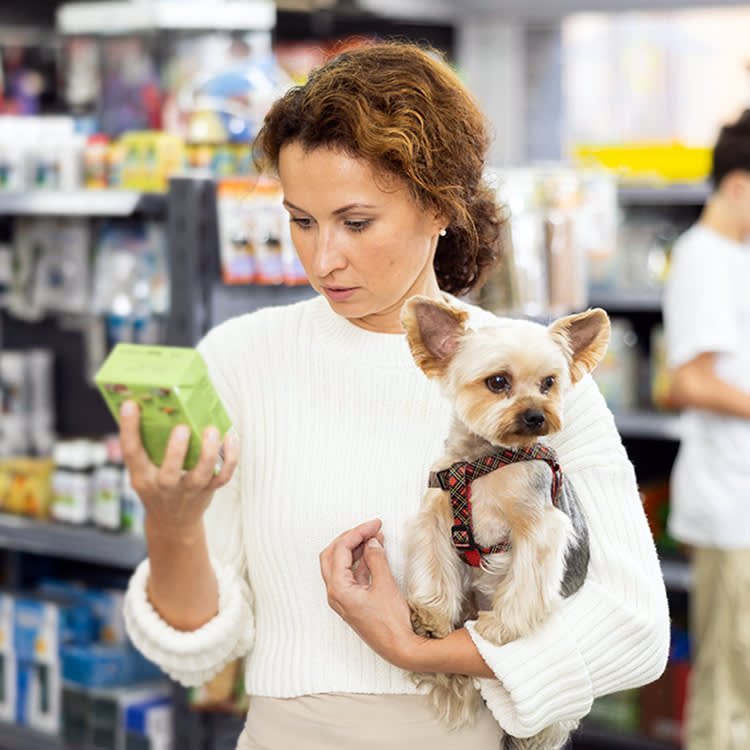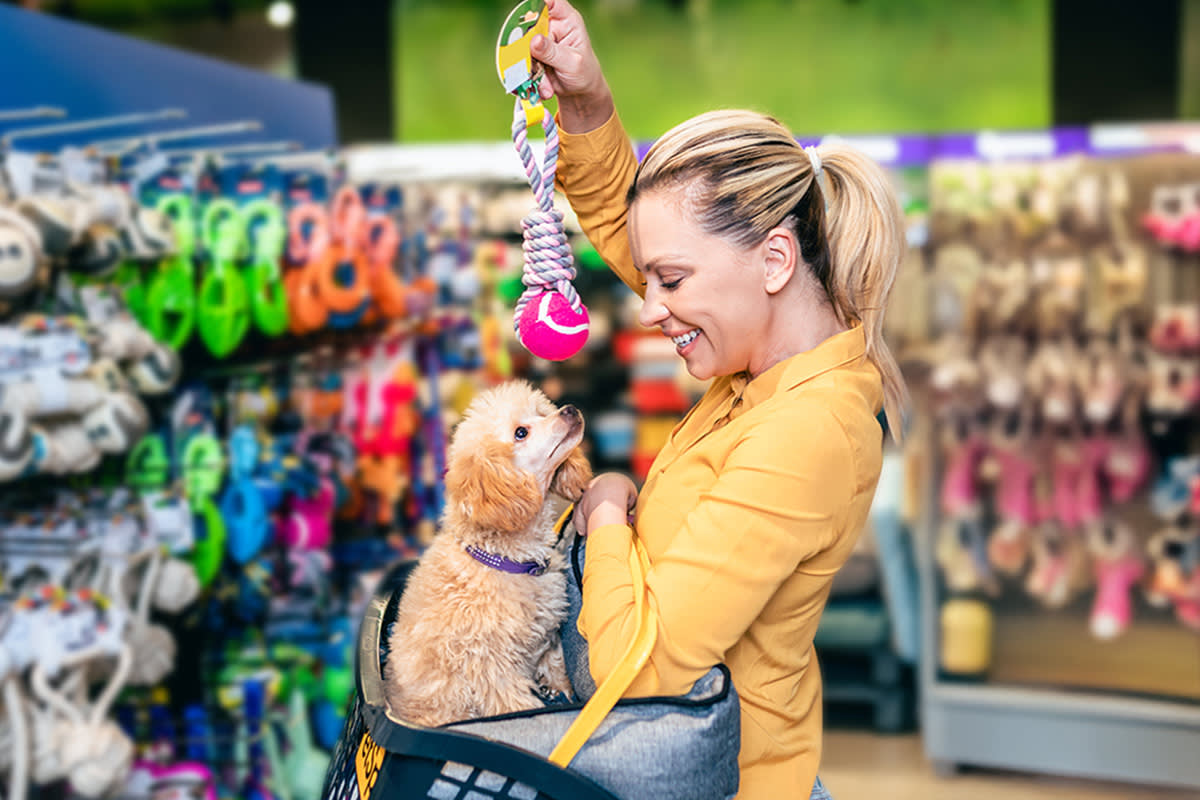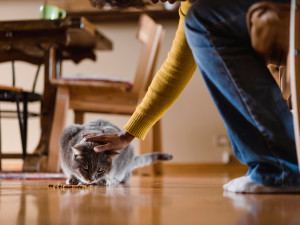How Tariffs Will Affect the Price of Pet Care
It might be time to take a look at your budget.

Share Article
We all love to spoil our pets, but the next few months might force us to take a closer look at how we spend our money. Tariffs are likely about to raise prices on foreign goods of all sorts, and unfortunately for our dogs and cats, that may include food, treats, toys, dog beds and accessories, vet bills, and more.
If economics makes you (understandably) spontaneously fall asleep, here’s a quick translation: A tariff is a tax imposed on a foreign good once it gets imported — usually, as a percentage of the item’s value. Domestic companies that import goods from other countries wind up paying the tariffs on those items. Because of that, San Francisco Chronicle personal finance columnist Jessica Roy tells Kinship, when tariffs go up, companies may either import fewer goods or raise prices to pass at least some of that increased cost to consumers.
But here’s where things get really annoying. Once prices go up, they don’t tend to go back down — even if the emergency situation that created the price increase ends. “Remember when it used to be free to check a bag on airplanes?” Roy says. “Airlines were permitted to start charging baggage fees to offset how much more gas cost. Gas prices came back down, and the baggage fees never went away.”
Other examples include car prices surging during the early days of COVID-19 pandemic because of chip shortages, and grocery prices rising due to inflation in 2022 and 2023. In both cases, prices never returned to normal. Sadly, the same will likely be true for rising pet-care costs.

If you’re wondering what tariffs could do to your pet-care budget, read on for expert advice from four personal-finance and economics experts to see which products will be hit the hardest — and what you can do to protect your wallet.
Look for “shrinkflation” and “skimpflation” in some pet foods.
The silver lining here is that according to multiple experts, pet food could face less-severe price hikes than other categories, like toys and accessories. That said, prices are still likely to rise.
The United States exports slightly more cat and dog food than it exports, according to Matthew MacLachlan — assistant professor at Charles H. Dyson School of Applied Economics and Management, who cites the USDA Foreign Agricultural Services’ Global Agriculture Trade Systemopens in new tab. The variety of pet foods on the market has led some countries to specialize in specific products. A lot of cat food brands, for instance, are based in Thailand — making it the largest exporter of pet food into the U.S. The U.S., meanwhile, makes a lot of premium and specialized pet foods.
Products from China will face the biggest shifts, MacLachlan says, because current tariff rates are above 100 percent. Meanwhile, the biggest wild card seems to be what will happen to prices on food that the U.S. produces.
Retaliatory tariffs on U.S. exports would make our products more expensive in the countries that enact them — which could essentially price us out of those markets. That could leave U.S.-based manufacturers with a surplus and, MacLachlan suspects, make their products cheaper for consumers at home. At the same time, U.S.-based pet food producers are going to face supply-chain challenges of their own — and that could still trickle down, too.
Hitendra Chaturvedi, professor of supply chain management at Arizona State University’s W. P. Carey School of Business, points out that some of the raw materials that U.S.-based companies use to make pet food — like corn meal, for example — come from Mexico. “If the raw material is expensive,” he says, “the final product is going to be expensive, too.” And as for those premium pet foods that come from the U.S.? They rely on vitamins imported from China — which means those companies’ costs will rise as well.
Even beyond the food itself, Roy notes, pet food manufacturers likely use machinery that relies on parts made in China. Employee uniforms likely come from China. The trucks they use to transport products and supplies probably use parts made in China. “And so even if the product you make comes entirely from the United States,” Roy says, “a lot of your other costs have gone up ... It’s really a butterfly effect.”
If your pet food costs begin to rise, it might be worth comparison shopping to see if you can find a better deal. That said, Chaturvedi warns, consumers have more to worry about than just price increases. You should also look out for “shrinkflation” — where you pay the same price, but the amount of product in a package decreases. And then there’s also “skimpflation,” where manufacturers swap out ingredients that have gotten more expensive for cheaper, sometimes inferior-quality options.
Pet toy prices are probably not going to be cute.
It’s a good thing our dogs and cats don’t need toys (at least not as often as they need food), because as Chaturvedi puts it, “That’s where we are going to get clobbered.”
To say that a vast majority of pet toys and accessories come from China would be a major understatement. The U.S. imported $721 million worth of pet toys last year, and according to the U.S. Census Bureau, a whopping 93 percent of those imports came from China, MacLachlan says. Because those products have been manufactured overseas for so long, consumers have gotten used to low prices — which leaves the companies that produce these products in a bind.
“Is a customer who would spend $12 for a pet toy going to spend $30 for a pet toy? $50 for a pet toy? No,” Roy says.
In times of economic uncertainty, consumers tend to cut down on non-essential purchases. So, when it comes to something like pet toys, manufacturers will be forced to ask themselves if it’s worth making a product that’s so expensive no one will buy it. In some cases, the U.S. might not even have the tools and labor marketopens in new tab needed to produce these items in the first place. “It’s not like we have a bunch of factories sitting empty and we can just flip the lights on,” Roy says.
Beyond price increases, Chaturvedi wouldn’t be surprised to see shortages — or at least reduced inventory — on items like pet toys, beds, grooming supplies, and more.
Veterinarians, groomers, boarding, and other pet-care services will probably cost more.
Your veterinarian’s time might not suddenly cost more, but Christopher Eaglin, assistant professor of strategy at the Fuqua School of Business at Duke University, notes that their “input costs” will increase. Think: medical supplies, equipment, etc. “Therefore, pet service prices might increase,” Eaglin says. “But it would depend on the foreign sourced components in that service.”
This is true for basically every kind of pet-care provider. Your groomer needs shampoo, nail clippers, and towels, Roy points out. Your kennel needs pet beds, food, and wee pads. Your pet insurance is tied to the veterinary industry, which will likely raise prices, so the insurance itself will become more expensive, too. As with other categories, we’ll likely see a cascade effect.
“Each business is different, and they may face different costs depending on their specialization, location, and existing equipment,” MacLachlan says. And while tariffs should not directly impact costs like labor, rent, and utilities, supplies produced abroad could be another story.
How long will tariff price increases last?
For starters, it’s unclear how long the tariffs themselves will last. As Roy points out, President Donald Trump tends to be “quite capricious” when it comes to policy decisions and has already done an about-face opens in new tab on tariffs once before. “The truth is, he could snap his fingers and change his mind about this stuff at any time,” she says. “So, it could all be wrapped up by the end of the week, and it could be months and months.”
And as for how long the price hikes tariffs might create could last? Eaglin expects that they’ll be around for at least as long as the tariffs are in place and probably much longer. If the tariffs are repealed, he says, “there might be some downward pressure on prices, but oftentimes, once the price level is set it rarely declines.”
At the same time, MacLachlan does offer one glimmer of hope: Research has shownopens in new tab that supply chain adjustments can help reduce tariff-induced price increases. That reduction, he says, “would depend critically on finding new trading partners with lower tariffs or establishing U.S. production.”
What can you do to save money?
For most of us, this will come down to cutting down on non-essential, or “discretionary,” purchases. Food and vet bills are unavoidable, but we may need to budget a bit more for the toys and accessories we buy our dogs. And for those purchases we can’t avoid, comparison shopping will be key.
“Like businesses are currently doing, until there is more clarity on tariffs and their pricing effects, consumers should hold off on major purchases and focus on spending on those items that are more necessities,” Eaglin says. He also suggests buying from local pet stores whenever possible.
And while the word “budget” might immediately make some of us cringe, Roy promises that keeping an eye on finances doesn’t have to feel like a punishment. If you’ve never made a budget before, she suggests a no-judgment month where you track your spending habits without trying to change them: “Just get a sense of what you’re spending, and make sure the stuff you’re spending money on is the stuff that brings you joy — and that brings your pets joy.”
Once you understand where your money is going, you can decide if the way you spend money really makes you happier and modify your choices accordingly. “I don’t think it’s like, you definitely have to cancel every single fun thing you do for your pet,” Roy says. “I think it's just a good time for everyone to be more conscientious and make sure their spending is aligning with their values and with what brings them joy.”

Laura Bradley
Laura is a New York-based experienced writer and mom of two rescue pups. Her work has appeared in Slate, Vanity Fair, Daily Beast, The Washington Post, The Atlantic, Yahoo! News, Vulture, Grazia Magazine, and more. When she is not writing or walking the pooches, you will probably find her in the community garden.
Related articles
![A woman in a bright yellow-orange sweater holding a striped kitten in one hand and a credit card in the other while using her laptop in front of her]()
How to Get Help With Vet Bills for Dogs Who Need Surgery
Worried about the cost of making your pet feel better? Help is on the way.
Is Your Pet More Pampered Than You? How to Know If You're Taking It Too Far
What dog doesn't need a spa day?
![A puppy getting a wound dressed at the vet]()
Which Pet Insurance Company Is Right for You?
We compared the top insurers so you don’t have to.
![A woman in a yellow sweater and jeans sitting and petting the head of her gray cat eating dry food from the floor in her kitchen]()
How to Find Free Pet Food Near You
These community resources can help your pet get the food they need.
How Much Will Your Dog Cost You in a Lifetime?
Our best friends are worth their weight in gold. But—it’s no big deal, just wondering—how much gold, exactly?
![Cat's Veterinary Check-up.]()
6 Ways You Can Get Help Paying for a Pet Care Emergency
Pet insurance is ideal, but there are some other options if you're stuck.








